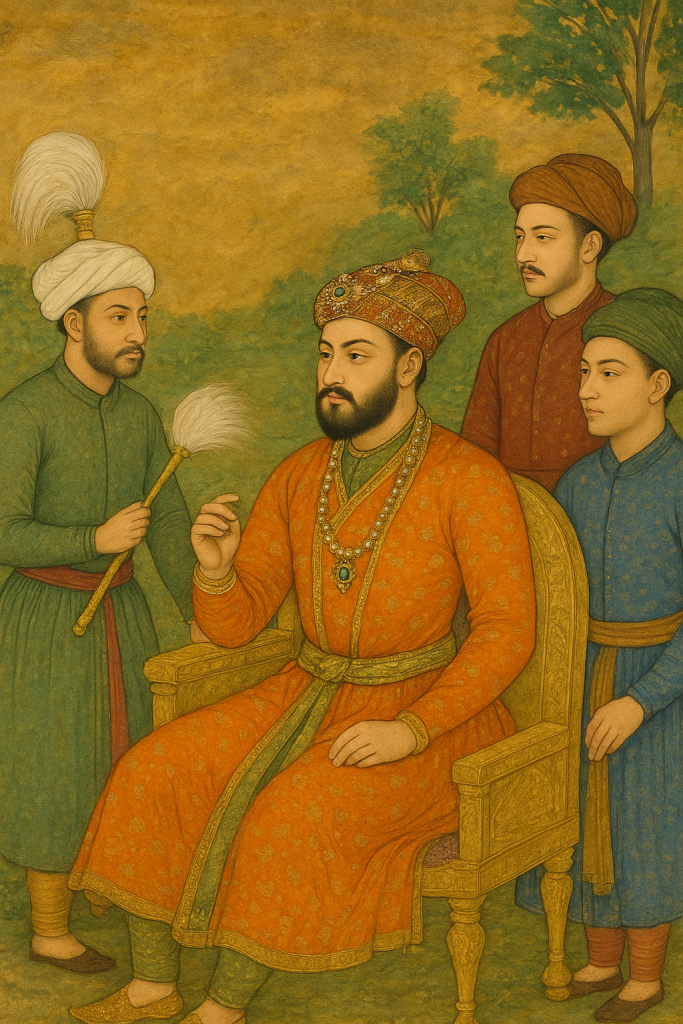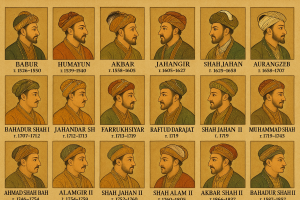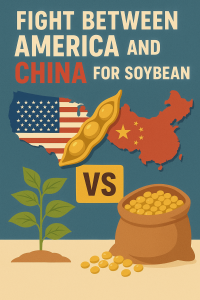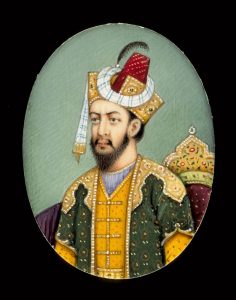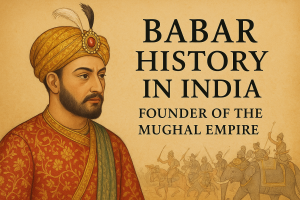Mughal Empire Ruled India
Who Ruled India Before Mughals A Complete Historical Overview
Before the Mughal Empire was established in 1526, India witnessed the rise and fall of many powerful dynasties. Discover who ruled India before the Mughals, from the Maurya Empire to the Delhi Sultanate.
Introduction mughal empire ruled india
The Mughal Empire in India (1526–1857) is often regarded as one of the greatest dynasties in Indian history. But before Babur founded the Mughal dynasty, India was home to several powerful rulers and empires. From ancient kingdoms to medieval sultanates, many dynasties shaped India’s political, cultural, and economic landscape
1. The Maurya Empire (322 BCE – 185 BCE)
- Founded by Chandragupta Maurya with guidance from Chanakya (Kautilya).
- Most powerful ruler: Ashoka the Great, known for spreading Buddhism.
- Famous for: centralized administration, Ashokan edicts, and the spread of Indian culture abroad.
2. The Gupta Empire (320 CE – 550 CE)
- Known as the Golden Age of India.
- Rulers: Chandragupta I, Samudragupta, Chandragupta II (Vikramaditya).
- Achievements: advancements in science, mathematics (Aryabhata), literature, and art.
3. Regional Kingdoms (600 CE – 1200 CE)
After the fall of the Guptas, India was divided into many kingdoms:
- Chalukyas in the Deccan
- Rashtrakutas in Central India
- Palas in Bengal
- Cholas in South India (famous for their navy and temple architecture)
4. The Delhi Sultanate (1206 – 1526 CE)
The most direct rulers before the Mughals were the Sultans of Delhi. The Delhi Sultanate consisted of five major dynasties:
- Mamluk (Slave) Dynasty (1206–1290) – Founded by Qutb-ud-din Aibak. Built Qutub Minar.
- Khilji Dynasty (1290–1320) – Alauddin Khilji expanded empire to South India.
- Tughlaq Dynasty (1320–1414) – Mohammad bin Tughlaq known for ambitious but failed reforms.
- Sayyid Dynasty (1414–1451) – Weak rulers, decline of Delhi power.
- Lodi Dynasty (1451–1526) – Ibrahim Lodi was the last Sultan, defeated by Babur in the First Battle of Panipat (1526).
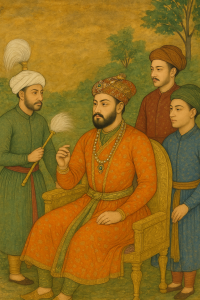
Mughal empire ruled india
Transition to the Mughal Empire ruled india
- The Lodi Dynasty was the last ruling power before the Mughals.
- Babur defeated Ibrahim Lodi at the First Battle of Panipat (1526) and established Mughal rule.
- This marked the shift from the Delhi Sultanate to the Mughal Empire, which went on to dominate India for over 300 years.
Before rule india, Mughal Empire, the mughal empire Ruled India was ruled by a series of powerful dynasties: the Mauryas, Guptas, various regional kingdoms, and finally the Delhi Sultanate. Each dynasty contributed to India’s history, culture, and heritage, creating a foundation on which the Mughals built their empire.
Mughal Empire Ruled India: History, Emperors, Culture & Legacy Who Ruled India Before Mughals
Discover the history of the Mughal Empire in India, its powerful emperors, rich architecture, cultural contributions, and the reasons for its decline. A complete guide to the Mughal dynasty from 1526 to 1857.
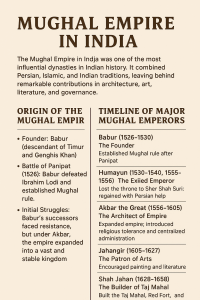
Introduction to Mughal Empire in India
The Mughal Empire Ruled India (1526–1857) was one of the most influential dynasties in Indian history.
It combined Persian, Islamic, and Indian traditions, leaving behind remarkable contributions in architecture, art, literature, and governance.
From the reign of Babur to the fall of Bahadur Shah Zafar, the Mughals shaped India’s cultural identity and political landscape.
Origin of the Mughal Empire
The Mughal dynasty traced its roots back to Central Asia.
- Founder: Babur (descendant of Timur and Genghis Khan)
- Battle of Panipat (1526): Babur defeated Ibrahim Lodi and established Mughal rule.
- Initial Struggles: Babur’s successors faced resistance, but under Akbar, the empire expanded into a vast and stable kingdom.
- delhi sulthanate
SEO Keywords to use here: Mughal Empire origins, Babur history, first Battle of Panipat.
Timeline of Major Mughal Empire ruled india
1. Babur (1526–1530) – The Founder
- Established Mughal rule after Panipat.
- Introduced Persian culture and military techniques.
- Memoirs: Baburnama.
2. Humayun (1530–1540, 1555–1556) – The Exiled Emperor
- Lost the throne to Sher Shah Suri.
- Regained with Persian help but died in 1556.
3. Akbar the Great (1556–1605) – The Architect of Empire
- Expanded empire to most of northern and central India.
- Introduced religious tolerance (Din-i-Ilahi).
- Developed Mansabdari system (administration).
- who ruled india before mughals
4. Jahangir (1605–1627) – The Patron of Arts
- Encouraged painting and literature.
- Married Nur Jahan, who played a key political role.
5. Shah Jahan (1628–1658) – The Builder of Taj Mahal
- Built the Taj Mahal, Red Fort, and Jama Masjid.
- Era of prosperity and architecture.
6. Aurangzeb (1658–1707) – The Last Powerful Emperor
- Expanded empire to its largest size.
- Strict Islamic policies caused discontent.
- Empire began weakening after his death.
7. Later Emperors (1707–1857)
- Weak rulers faced invasions (Nadir Shah, Ahmad Shah Abdali).
- Rise of Marathas, Sikhs, and British reduced Mughal power.
- Bahadur Shah Zafar was the last emperor, exiled in 1857 by the British.Who Ruled India Before Mughals
Contributions of the Mughal Empire ruled india
1. Mughal Architecture
- Taj Mahal (Agra) – Symbol of love.
- Red Fort (Delhi) – Political seat of power.
- Humayun’s Tomb – Early Mughal architecture.
- Fatehpur Sikri – Capital city built by Akbar.
2. Language & Literature
- Development of Urdu language.
- Persian became the official court language.
- Rich heritage of poetry, chronicles, and memoirs.
3. Art & Culture
- Mughal miniature paintings.
- Calligraphy and Persian garden styles.
- Fusion of Hindu and Islamic traditions.
4. Administration
- Mansabdari system – Military-civil ranking system.
- Land revenue (Zabt system).
- Strong centralized bureaucracy.
5. Economy & Trade
- Development of Urdu language.
- Persian became the official court language.
- Rich heritage of poetry, chronicles, and memoirs.
3. Art & Culture
- Mughal miniature paintings.
- Calligraphy and Persian garden styles.
- Fusion of Hindu and Islamic traditions.
4. Administration
- Mansabdari system – Military-civil ranking system.
- Land revenue (Zabt system).
- Strong centralized bureaucracy.
5. Economy & Trade
- Agricultural prosperity (wheat, rice, sugarcane).
- Trade with Central Asia, Middle East, and Europe.
- Growth of Indian textiles (silk, cotton, muslin).
Decline of the Mughal Empire ruled india
Causes of Decline:
- Weak successors after Aurangzeb.
- Rise of regional kingdoms (Marathas, Sikhs, Nawabs).
- Foreign invasions (Nadir Shah’s plunder of Delhi in 1739).
- British East India Company’s growing power.
- Revolt of 1857 ended Mughal rule officially.
Legacy of the Mughal Empire in India
Even after its downfall, the Mughal dynasty’s influence remains:(Who Ruled India Before Mughals)
- Architectural marvels like the Taj Mahal attract millions worldwide.
- Cultural blend of Indian, Persian, and Islamic traditions.
- Administrative systems adapted later by the British.
- Contribution to Indian cuisine (Mughlai food).
FAQs on Mughal Empire ruled India
Q1: Who was the greatest Mughal Emperor?
Akbar the Great, due to his policies of tolerance and expansion.
Q2: What was the capital of Mughal Empire?
Primarily Agra and Delhi.
Q3: Who built the Taj Mahal?
Emperor Shah Jahan in memory of his wife Mumtaz Mahal.
Q4: Who was the last Mughal emperor?
Bahadur Shah Zafar (exiled in 1857).

